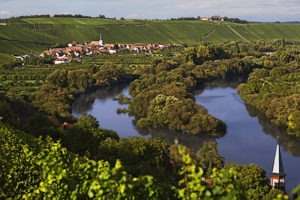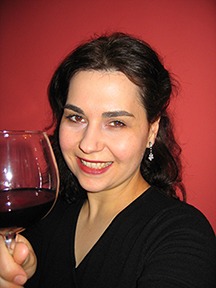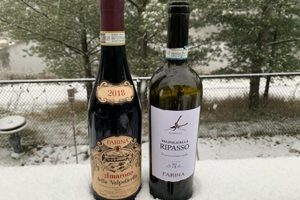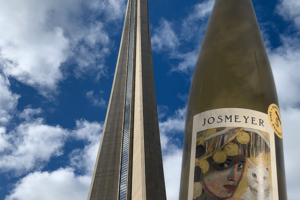German wine, you ask? That’s just sweet Riesling, right?
Oh, those dang stereotypes.
 OK, yes, they make Riesling. OK, A LOT of Riesling—despite having just 1.35% of the world’s vineyard surface area, Germany accounts for a mind-boggling half of the planet’s Riesling acreage. And warmer weather patterns are only making life easier for German winemakers.
OK, yes, they make Riesling. OK, A LOT of Riesling—despite having just 1.35% of the world’s vineyard surface area, Germany accounts for a mind-boggling half of the planet’s Riesling acreage. And warmer weather patterns are only making life easier for German winemakers.
“So far, Germany has been a beneficiary of climate change,” explains Master of Wine Anne Krebiehl. “Northern regions used to have three decent vintages a decade. Today, Riesling ripens reliably (across the country). So that’s why I can never answer the question, ‘What is a German Riesling?’ They’re as varied and scintillating as a peacock’s tail.”

Master of Wine Anne Krebiehl and Master Sommelier John Szabo (below).
While we’re at it, we may want to expose a myth about German reds as well. “Just about a third of Germany’s vineyards are now planted with red grapes, which used to be unthinkable,” Krebiehl adds.
THE RISE OF PINOT NOIR
While a milder climate is starting to make life difficult for those who require cold winters for the manufacture of Icewine, it has helped give rise to Spätburgunder, the German name for pinot noir. Of all the information presented in a Wines of Germany video seminar last week for Canadian media and trade, the most eyebrow-raising tidbit for me was that Germany is now the world’s third-largest grower of Pinot Noir. And we sampled a pair of very polished Spätburgunders during the session: the 2017 Stodden JS ($38 at the LCBO) and 2016 RS Salwey ($44.75).
“This wine, for me, encapsulates the evolution of German pinot noir—a wine of finesse and  delicacy,” observed Master Sommelier John Szabo, a co-host of the event, of the RS Salwey Pinot. “Ten years ago, I was tasting a lot of overripe and over-oaked wines, but this is tout en finesse.”
delicacy,” observed Master Sommelier John Szabo, a co-host of the event, of the RS Salwey Pinot. “Ten years ago, I was tasting a lot of overripe and over-oaked wines, but this is tout en finesse.”
GERMANY’S INHERENT ADVANTAGES
For all the talk of climate change, 11 of Germany’s 13 wine regions are crowded into the southwest of the country, where you can find a remarkable mix of soil types—everything from sand and loam to volcanic—mirroring the diversity of Alsace, France, just across the border. That allows for a very wide range of wine styles in a tight pocket of real estate.
The vast majority of those southwest German vineyards slope steeply toward the Rhine or its tributaries. And that takes advantage of something Germany might have more than any other winemaking country: daylight hours, thanks to its high latitude. “And it’s light, not heat, that ripens grapes,” notes Krebiehl. “And Riesling loves those long Indian summers. But without (too much) heat, it slows down sugar creation, livens up the aromatics and preserves acidity. The crucial ripening doesn’t happen during the summer; it’s those cooler, lighter, lovely (autumn days).”
“I had a grower who threw at me (the number of) 160 days from flower to harvest, whereas most of the rest of the world works on a 100-112 days, so it’s an extraordinary long growing season,” echoed Szabo. “It’s one thing that helped me understand how you could have such flavourful wines on such a featherlight frame with low alcohol but high acids—but not (to the point where they’re) green or short on flavour.”
GERMAN ENGINEERING
Then there’s just the fact that these wines are being made by…well, Germans. Yes, it’s a stereotype, but there was clearly some impressive German workmanship in the eight wines we sampled last week, and no shortage of organic and biodynamic practices enhancing the finished product. And it’s not as though winemaking is exactly new to the region. It’s believed that the Romans brought wine vines to the Mosel and the Rhine in 371 AD. And while one naturally thinks of happily imbibed patrons clinking pints of beer in German bars, it was around 800 AD that Emperor Charlemagne actually created wine taverns in the Rheingau region!

Our lineup of eight wines.
There have been a couple of happy accidents along the way that have led to the Germans’ creation of late harvest wine and Icewine, as well as groundbreaking research with respect to wine clones. But let’s get to why Germans have been spending more money on wine than beer since 2001.
THE RIGHT STUFF
While it might be slightly warmer than it used to be in Germany, this isn’t the Mediterranean, so you need grapes that require lower annual temperatures. We were introduced to a handful that are ideal for the locale:
Grauburgunder: (Pinot Gris): As Krebiehl describes it, German Pinot Gris is very much pitched between the easy-drinking, light-bodied style you’ll find in most Italian Pinot Grigio, and the richer, riper, spicier, full-bodied Alsacian style. The silky $30 Dreissigacker Organic Grauburgunder we sampled fit that description perfectly (search for it at the LCBO Germany Destinations Collection).
Weissburgunder: (Pinot Blanc) “Nobody grows as much of this grape as Germany. And few places give it its due as much as Germany, Italy and Austria,” says Krebiehl. “I think this is the sleeper. It can be an incredibly elegant, nuanced grape variety.”
It’s also good bet to please a gamut of white wine drinkers, given its combination of crispness and texture.
 The 2017 Wittman Weisserburgunder Trocken —a key word you need to learn when looking at German wines is “Trocken,” which means “dry”—was extremely impressive. The winery has been certified biodynamic since 2004 and organic since 1990. Dry but dense with great legs and no obvious oak, and at an adffordable $24.95, this style of wine is hugely popular in Germany right now, where tastes are now leaning to the dry side.
The 2017 Wittman Weisserburgunder Trocken —a key word you need to learn when looking at German wines is “Trocken,” which means “dry”—was extremely impressive. The winery has been certified biodynamic since 2004 and organic since 1990. Dry but dense with great legs and no obvious oak, and at an adffordable $24.95, this style of wine is hugely popular in Germany right now, where tastes are now leaning to the dry side.
Silvaner: Krebiehl loves this white wine variety. “It’s a more full bodied white, a sleeper variety,” she says. “It gets under your skin because it is no less expressive of its prominence than Riesling. It’s a beautiful thing. A food-wine par excellence, especially for those who struggle with Riesling’s acid.”
Trollinger: Krebiehl says that, in the hands of a good winemaker, “this can be a sexy grape. Light-bodied and coloured, but fresh and fruity—a summer chiller.”
“A wine of the times,” adds Szabo.
Lemberger: Germany’s only full-bodied red. It makes for some “incredibly poetic, spicy wines,” Krebiehl says. “High acidity but also with this body and spice. Some are beautifully floral.” It’s a great pairing for anything from poultry to lamb. The one we tried, a 2016 Graf Neipperg Schwaigerner Ruthe ($67.25), showed off that wild peppery vein. It was dry and clearly possessed some great aging ability.
Spätburgunder: The aforementioned Pinot Noir. With a moderating climate, expect this to continue to be a growing segment for Germany.
Riesling: If Krebiehl wanted to get one point across during last week’s seminar, it was the diverse style of wines that Germany offers, and nowhere was that clearer than with the three Rieslings we tasted. We started with 2017 Christmann Riesling Trocken ($33.55 from CGU Fine Wines), a very high-quality Riesling from Pfalz, one of Germany’s most southernmost wine regions. Sophie Christmann, the third woman to take over the estate, explains that her ancestors have been growing wine in the area since 1506, and the winery has been around since 1798! Biodynamically made, there’s a salty minerality derived from their vineyards’ red sandstone and limestone. It’s Riesling, but it comes across as almost bone dry, with a wonderfully elegant texture.
 The most unique wine of the session was the 2016 Clemens Busch Marienburg Falkenlay Riesling Trocken from Mosel, a fairly recent release at the LCBO that retails for $60). “It’s got that Devonian slate smell of the Mosel,” Krebiehl describes. “It’s like drinking liquid rock. There’s something bitter, but in a nice way, in the way of bitter almonds.”
The most unique wine of the session was the 2016 Clemens Busch Marienburg Falkenlay Riesling Trocken from Mosel, a fairly recent release at the LCBO that retails for $60). “It’s got that Devonian slate smell of the Mosel,” Krebiehl describes. “It’s like drinking liquid rock. There’s something bitter, but in a nice way, in the way of bitter almonds.”
The sweetest of our wines was saved for last, the $34 2018 Hofgut Falkenstein Neidermenniger Herrenberg Spätlese Feinherb (you’ll have to special-order this one). This producer is the master of feinherb (think of the dry side of off-dry Riesling), but there’s such a lively acidity that much of the sugar is masked, restoring the balance of a salivating drinking experience.
In describing the wine, Szabo quoted wine writer Hugh Johnson: “German wine is epitomized nowhere better than in the valley of the Mosel’s tributary, the Saar. The battle for sugar in grapes rages most fiercely in this cold corner of the country, yet successful years give one of the world’s superlative and inimitable white wines; every mouthful a cause for rejoicing and wonder.”
“Electric and sexy,” added Krebiehl. “If you want Riesling, you want thrill. And I am thrilled.”
.




Leave a Reply
Your email is safe with us.